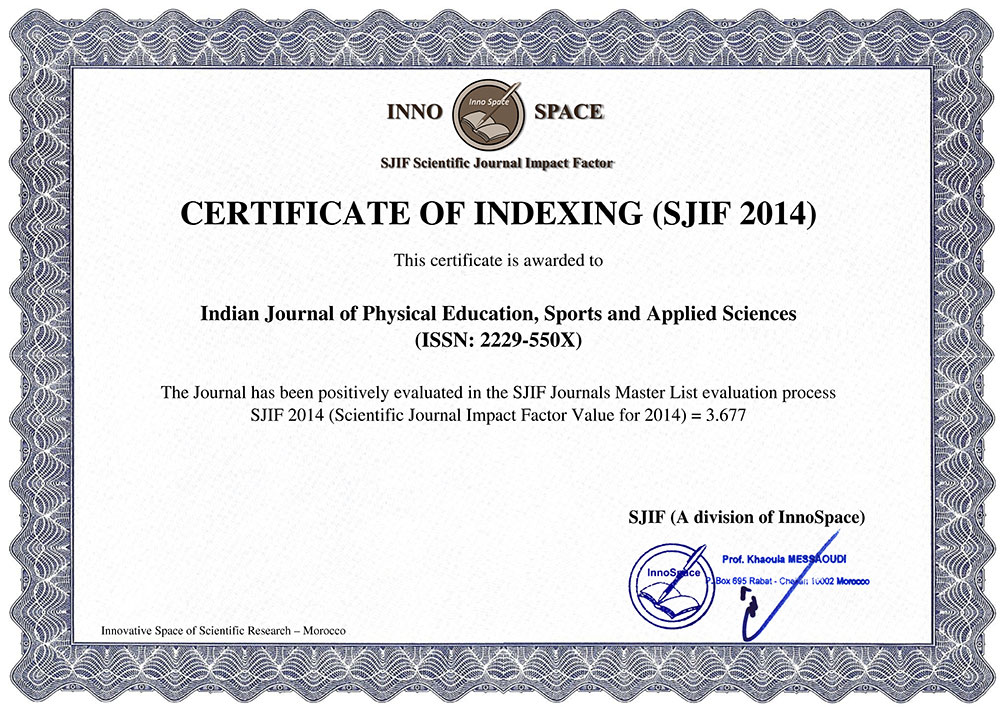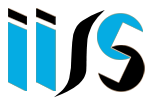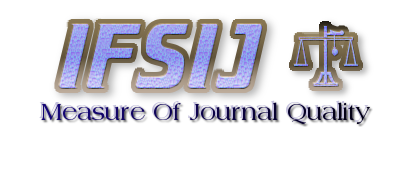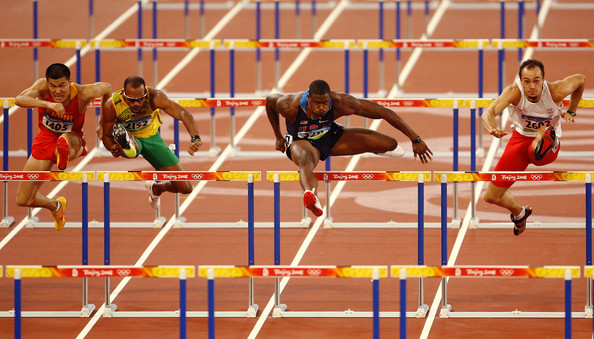EXAMINING MOTIVATION FOR SPORTS PARTICIPATION IN YOUTH OF GOA PARTICIPATING IN INDIGENOUS AND NON-INDIGENOUS SPORTS
Volume 7-Number 4, October, 2017 November 5, 2017| Author name : | Shreenivas Harikanth and GajananaPrabhu B. | ||||
|---|---|---|---|---|---|
| Page no : | 11-17 | Volume : | 7 | Issue : | 4 |
doi no.: 05-2016-44975451, DOI Link :: http://doi-ds.org/doilink/11.2017-52289599/
Shreenivas Harikanth 1 and GajananaPrabhu B. 2
Affiliations
1 Research Scholar, Department of P.G. Studies and Research in Physical Education, Kuvempu University, Shimoga, Karnataka 577451 INDIA
2 Assistant Professor, Department of P.G. Studies and Research in Physical Education, Kuvempu University, Shimoga, Karnataka INDIA Email: prabhuji888@gmail.com
ABSTRACT
The state of Goa has one of the most extensive health systems in India, prevention, early detection and management of lifestyle disorders and other non-communicable diseases is of prime importance. Youth concerns have been recognized by the National Youth Policy. Research led by the authors in the state of Goa has reported strong relationships between reproductive tract complaints, tobacco and alcohol use, depression, and experiences of violence, indicating that these diverse outcomes may influence each other and/or may share similar risk factors. Physical activities, sports and other allied activities play an important role in dealing lifestyle related disorders prevailing in the state of Goa. A detailed assessment of motivations for participation in physical activities and sports is the need of the hour. Hence, researcher was of specific interest to examine and compare the motivation for sports participation in youth of Goa participating in indigenous and non-indigenous sports. The subjects for the study were 254 young men (N-173) and women (N=81) belonging to the state of Goa. Their age ranged between 16 to 25 years. All the subjects were amateur sportspersons playing from inter-collegiate to National level. The sports persons in indigenous sports events (N=43 in boys and N= 29 in girls) included Kabaddi and Kho-kho; and the non-indigenous (N=130 in boys and N= 52 in girls) included football, cricket, volleyball, Table tennis, Badminton, Hockey, Handball etc. Data on motivation for participation in sports was collected through The 24-item Sport Motivation Scale (Mallett, et. al. (2007). Purposive random sampling was used in the present investigation. The data was collected by the researcher himself during spare time of the subjects with proper orientation. Independent sample ‘t’ test was calculated along with mean and standard deviation. Male and female youth of Goa participating in Non-indigenous sporting events like football and cricket have greater motivation than their counterparts in indigenous sports events.
Keywords: youth, Goa, sports, indigenous, football, health, non-communicable diseases, motivation.
DOWNLOAD FULL TEXT: 
BIBLIOGRAPHY
Allen, J. B. (2003). “Social Motivation in Youth Sport”, Journal of Sport & Exercise Psychology, 2003, 25,551 -567 Kondric, M., Sindik, J., Furjan-Mandic, G. and Schiefler, B. (2013) “Participation Motivation and Student’s Physical Activity among Sport Students in Three Countries”, Journal of Sports Science and Medicine 12, 10-18
Balaji, M., Andrews, T., Andrew, G. and Vikram Patel (2010). “The Acceptability, Feasibility, and Effectiveness of a Population-based Intervention to Promote Youth Health: An Exploratory Study in Goa, India”, Journal of Adolescent Health 48; PP:453–460.
Chari, B. (2014). Goa will get just 500 charters from Russia. The Times of India. 24th October.
Chen X, Fang X, Li X, et al. (2006). Stay away from tobacco: A pilot trial of a school-based adolescent smoking prevention program in Beijing, China. Nicotine Tob Res 8(2):227–37.
Citizen Charter (2008). Government of Goa, Published by Health Intelligence Bureau Directorate Of Health Services Available at: http://www.un.org.in/adolescentsfinalbook-800kb.pdf.
Economic Survey (2013–14). Directorate of Planning, Statistics and Evaluation, Government of Goa.
Falleiro, S. P. (2015). “The economic and socio-cultural balance sheet of tourism in Goa: Future options”, International Journal of Scientific and Research Publications, Volume 5, Issue 2; PP: 01- 07.
Kamat, S.B. (2010). Destination Life Cycle and Assessment – A Study of Goa Tourism Industry. South Asian Journal of Tourism and Heritage , Vol. 3(2). pp 139-147.
Mallett, C., Kawabata, M., Newcombe, P., Otero-Forero, A. & Jackson, S. (2007). “Sport motivation scale-6 (SMS-6): A revised six factor sport motivation scale”, Psychology of sport and exercise; Vol-8; PP:600-614.
Mbizvo MT, Kasule J, Gupta V, et al. (1997). Effects of a randomized health education intervention on aspects of reproductive health knowledge and reported behaviour among adolescents in Zimbabwe. Soc Sci Med., 44(5): 573–7.
NYP (2003). National Youth Policy 2003 http:// www. youthpolicy. com/ Policies /India NATIONALYOUTHPOLICY2003 .pdf, 2003.
Patel V and Andrew G. (2001). Gender, sexual abuse and risk behaviours: A cross sectional surveys in schools in Goa. Natl Med J India, 14:263–7.
Pelletier, L. G., Fortier, M. S., Vallerand, R. J., Tuson, K. M., Briere, N. M., &Blais, M. R. (1995). Toward a new measure of intrinsic motivation, extrinsic motivation, and amotivation in sports: The Sport Motivation Scale. Journal of Sport & Exercise Psychology, 17, 35-53.
Pillai A, Patel V, Cardozo P, et al. (2008). Non-traditional lifestyles and prevalence of mental disorders in adolescents in Goa, India. Br J Psychiatry, 192:45–51.
Reddy KS, Arora M, Perry CL, et al. (2002). Tobacco and alcohol use outcomes of a school- and family-based intervention with young adolescents in New Delhi, American. J Health Promot., 26:173–81.
Speizer IS, Magnani RJ, Colvin CE.(2003). The effectiveness of adolescent reproductive health interventions in developing countries: A review of the evidence. J Adolesc Health., 33:324–48.
Tsitskari, E., Vernadakis, N., Foridou, A. and Bebetsos, E. (2015). Assessing adolescents’ sport participation motives: psychometric evaluation of BRSQ. Motricidade, [S.l.], v. 11, n. 1, p. 64-77, apr. 2015. ISSN 2182-2972.
Vallerand, R. J., & Losier, G. F. (1999). An integrative analysis of intrinsic and extrinsic motivation in sport. Journal of Applied Sport Psychology, 11, 142-69.







